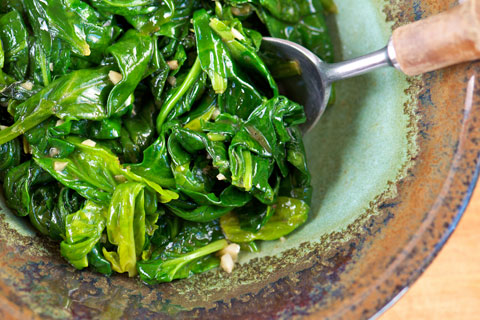Nutrients in Spinach Have Cancer-Fighting Effects

Fun Facts:
Spinach wasn't always a popular vegetable in the United States — until the cartoon character Popeye vouched for its health and strength-building attributes and increased spinach sales by over 30%. (i.1)
In ancient China spinach was presented as a royal gift from the king of Nepal and was known as the herb of Persia. (i.1)
Spinach (Spinacia oleracea) has bright, vibrant leaves that are not only pleasing to the eye but also contain many nutrients. Originally believed to have originated in ancient Persia, this vegetable has been commonly used in the United States since the beginning of the 19th century. Spinach is another tasty member of the same vegetable family as beets and Swiss chard, and like its cousins is also high in nutritional value (especially high in vitamin A, vitamin C, and vitamin K). (i.107, 108)
Types of Spinach
There are three basic types of spinach: savoy, smooth-leaf, and semi-savoy. The dark green leaves of savoy spinach are curled and crinkly while those of the semi-savoy type are only slightly curled, which makes them slightly easier to clean than the savoy leaves. Smooth or flat leaf spinach has spade-shaped leaves that are not curled. It has a milder taste compared to the other two types and is commonly used in frozen or canned forms. Savoy and semi-savoy types are usually sold fresh, although the latter is also contained in some processed foods. (i.108)
Nutrients in Spinach
Low in calories, spinach is among the healthiest vegetables in the world, leading in terms of nutrient richness: (i.42, 54, 57, 99, 107-115)
|
SPINACH (1 CUP, RAW, 30 G) |
SPINACH (½ CUP PREPARED FROM FROZEN, 95 G) | |||||
|---|---|---|---|---|---|---|---|
| Calories | 6.9 | 30.4 | |||||
| Fiber | 0.66 g | 3.515 g | |||||
| Net Carbohydrates | 0.429 g | 1.387 g | |||||
| Oxalate | 587.7 mg | ||||||
| Vitamins and Natural Antioxidants | |||||||
| Alpha-tocopherol (form of vitamin E) | 0.069 mg | 3.363 mg | |||||
| Choline | 5.4 mg | ||||||
| Coenzyme Q10 | |||||||
| Folate | 58.2 mcg | 114.95 mcg | |||||
| Folic acid (vitamin B9) | |||||||
| Gamma-tocopherol (form of vitamin E) | 0. 054 mg | 0.162 mg | |||||
| Glutathione (an antioxidant) | |||||||
| Niacin (vitamin B3) | 0.217 mg | 0.412 mg | |||||
| Pantothenic acid (vitamin B5) | 0.02 mg | 0.071 mg | |||||
| Riboflavin (vitamin B2) | 0.057 mg | 0.167 mg | |||||
| Thiamine (vitamin B1) | 0.023 mg | 0.074 mg | |||||
| Vitamin A | 2,813.1 IU | 11,457.95 IU | |||||
| Vitamin B6 (pyridoxine) | 0.059 mg | 0.129 mg | |||||
| Vitamin C | 8.43 mg | 2.09 mg | |||||
| Vitamin K | 144.87 mcg | 513.665 mcg | |||||
| Fatty Acids | |||||||
| Alpha linolenic acid | |||||||
| Cephalin | |||||||
| Lecithin | |||||||
| Linoleic acid | |||||||
| Lipoic acid (lipoyllysine) | |||||||
| Myristic acid | |||||||
| Oleic acid | |||||||
| Omega-3 | 0.041 g | 0.204 g | |||||
| Omega-6 | 0.008 g | — | |||||
| Palmitic and palmitoleic acids | |||||||
| Minerals | |||||||
| Boron | |||||||
| Cadmium | |||||||
| Calcium | 29.7 mg | 145.35 mg | |||||
| Copper | 0.039 mg | 0.153 mg | |||||
| Fluorine | |||||||
| Iron | 0.813 mg | 1.862 mg | |||||
| Magnesium | 23.7 mg | 77.9 mg | |||||
| Manganese | 0.269 mg | 0.681 mg | |||||
| Phosphorus | 14.7 mg | 47.5 mg | |||||
| Potassium | 167.4 mg | 286.9 mg | |||||
| Selenium | 0.3 mcg | 5.225 mcg | |||||
| Vanadium | |||||||
| Zinc | 0.159 mg | 0.465 mg | |||||
| Carotenoids (Tetraterpenes) | |||||||
| Beta carotene | 1,687.8 mcg | 6,875.15 mcg | |||||
| Lutein and zeaxanthin | 3,659.4 mcg | 14,905.5 mcg | |||||
| Violaxanthin and neoxanthin (epoxy xanthophyll carotenoids) | |||||||
| Amino Acids and Neurotransmitters | |||||||
| Acetylcholine (a neurotransmitter) | |||||||
| Alanine | 0.043 g | 0.21 g | |||||
| Arginine | 0.049 g | 0.533 g | |||||
| Aspartic acid | 0.072 g | 0.437 g | |||||
| Cysteine | 0.011 g | 0.017 g | |||||
| Dopamine (a neurotransmitter) | |||||||
| Glutamic acid | 0.103 g | 0.481 g | |||||
| Glycine | 0.04 g | 0.212 g | |||||
| Histidine | 0.019 g | 0.021 g | |||||
| Isoleucine | 0.044 g | 0.115 g | |||||
| Leucine | 0.067 g | 0.162 g | |||||
| Lysine | 0.052 g | 0.247 g | |||||
| Methionine | 0.016 g | 0.056 g | |||||
| N-acetyl histamine (a neurotransmitter) | |||||||
| Phenylalanine | 0.039 g | 0.21 g | |||||
| Proline | 0.034 g | 0.198 g | |||||
| Serine | 0.031 g | 0.157 g | |||||
| Threonine | 0.037 g | 0.223 g | |||||
| Tryptophan | 0.012 g | 0.103 g | |||||
| Tyrosine | 0.032 g | 0.232 g | |||||
| Valine | 0.048 g | 0.166 g | |||||
| Flavonoids and Other Beneficial Phytochemicals (1,000 mg of flavonoids in every kg of fresh spinach) | |||||||
| Apigenin (a flavone) | |||||||
| Betaine | 165.1 mg | ||||||
| Coumestrol | |||||||
| Ecdysteroids | |||||||
| Ferulic acid | |||||||
| Glycoglycerolipids (mostly monogalactosyl diacylglycerol, digalactosyl diacylglycerol, and sulfoquinovosyl diacylglycerol) | |||||||
| Kaempferol (a flavonol) | 0.003-2.28 mg | ||||||
| Luteolin (a flavone) | 0.333 mg | ||||||
| Myricetin (a flavonol) | 0.003 mg | ||||||
| Patuletin | |||||||
| Quercetin (a flavonol) | 1.458 mg | ||||||
| Spinacetin | |||||||
Evidence for Cancer-Fighting Benefits of Spinach Compounds
So how do the nutrients and phytochemicals in spinach work against cancer? It turns out that spinach has both chemopreventive and anticancer properties, meaning it can prevent the development of cancer and stop cancer cells from growing and spreading. (i.116)
Spinach has high phytonutrient content compared to other vegetables. Over a dozen different types of flavonoids found in spinach have anti-cancer, anti-mutagenic, and anti-inflammatory properties — including luteolin. This has led researchers to prepare special extracts for controlled laboratory studies that have been shown to check the division of human stomach cancer cells. Spinach also showed strong activity against breast and liver cancer cell lines and extracts reduced skin cancer growths in laboratory animals. (i.107, 113, 117, 118)
While no clinical evidence exists on any specific therapeutic dosage when spinach is used as a drug, the vegetable is generally recognized as safe when used as food. There are no known contraindications to its use and any allergic reactions related to it are rare. (i.119)
Chemoprevention
Different studies have shown that spinach has potent antioxidant properties that help in preventing cancer among other serious health problems. Antioxidants are useful substances in preventing free radicals (unstable molecules) from damaging cells and leading to cancer. The antioxidants do this by stabilizing the free radicals. Studies analyzing the antioxidant capacity of individual foods found that spinach has the highest capacity to neutralize free radicals. Different laboratory tests have shown that antioxidants help to slow down and even prevent cancer development. (i.119-121)
One of the anti-cancer compounds that spinach contains is glycoglycerolipids, which studies show are potent DNA polymerase inhibitors. Many plants contain glycoglycerolipids in the membranes of their light-sensitive parts, which help them in carrying out photosynthesis. Recent laboratory studies have demonstrated that the glycoglycerolipids found in spinach are also especially good at protecting the lining of the digestive tract from the damage caused by unwanted inflammation. This anti-inflammatory effect could help prevent cancer from developing. (i.107, 116, 117)
Antitumor Activity
Part of the normal function of cells is to divide and replicate, reproducing duplicate copies. When the body senses DNA damage in a cell, it stops the cell from proceeding in its growth cycle and stimulates enzyme proteins called DNA polymerases to repair the damage. Sometimes this DNA repair mechanism malfunctions, enabling the cancer cells to proliferate. In fact, dysfunctional polymerases also make tumors resistant to chemotherapy-induced cancer cell death, and cancer researchers are now looking for substances that can target and inhibit these DNA polymerases. (i.116, 122, 123)
In the lab, spinach glycoglycerolipids inhibited DNA polymerase (pol α) involved in cell replication in human cervical cancer cells. It also stopped cancer cell growth and induced cancer cell death in the following types of human cancer cell lines: (i.116)
- B-cell acute lymphoblastoid leukemia
- Cervical cancer
- Lung cancer
- Stomach cancer
- T-cell acute lymphoblastic leukemia
Oral administration and injection of spinach glycoglycerolipids also induced colon and sarcoma cancer cell death in animal studies, reducing sarcoma tumor growth by 90% compared to control. In the animal model for colon cancer, spinach inhibited solid tumor growth and blocked polymerases that are involved in metastasis. Both animal studies showed no adverse effects (such as loss of body weight, death, or organ damage). (i.116)
When the relationship between vegetable consumption and prostate cancer risk was researched, spinach was the only vegetable that showed significant protection against aggressive stage III and IV prostate cancers. Spinach also contains epoxy xanthophylls, a unique type of carotenoid, and the flavone flavonoid apigenin, both of which have anti-tumor properties. (i.107, 117)
Adding Spinach to Your Diet
Spinach is sold in fresh, frozen, or canned forms. When purchasing fresh spinach, look for vibrant deep green stems and leaves without any yellowing signs. Avoid limp, spotted, or damaged leaves. If fresh spinach is not readily available, frozen spinach is a good alternative, having almost as high levels of antioxidant polyphenols such as flavonoids as fresh spinach. It may be an especially good idea to look for organic spinach since commercial fertilizers contain large amounts of nitrates, and leafy vegetables such as spinach tend to accumulate these nitrates, which are potentially hazardous. (i.107, 108, 117, 124)
Fresh spinach should not be washed prior to storing, as water makes them spoil faster. Spinach should be placed loosely in plastic bags and as much air as possible squeezed out before refrigerating. When stored correctly in the refrigerator, spinach should remain fresh for five days. At room temperature, spinach can lose almost all its vitamin C within three days. (i.107, 108, 125)
Preparing Spinach
Since spinach is generally grown in sandy soil, the leaves must be washed well. Tear the stem off and separate the leaves before placing them in a large bowl of water. The leaves should then be cleaned gently, allowing the sand to settle to the bottom and repeating the process as necessary. Swishing the leaves around helps to dislodge dirt. Soaking the leaves leads to the loss of water-soluble nutrients. Spinach is one of the few vegetables that some experts recommend boiling as a preferred way to cook since it helps to free up the oxalic acids in spinach into the water (which should be discarded after cooking). (i.107, 108)
Spinach can be served in a variety of ways, including: (i.107, 108)
- Mixed with other fruits, vegetables, and nuts in a salad that can be used as a side dish or even a main course.
- Adding pine nuts to cooked spinach.
- Adding some layers of steamed spinach to a lasagna recipe or sautéed and added to the sauce for Chicken Florentine.
Growing Spinach
Spinach does best in a sandy loam soil with good drainage, which makes it easy to harvest after rainfall. The vegetable should be grown during cool seasons. Plant spinach seeds in the early spring when soil temperature has reached 45°F, using lots of compost. Watering should be uniform and weeds removed by hand. Spinach takes between 28 and 45 days to mature. When harvesting, only cut full-size leaves and leave the crown to grow again. (i.126)
Be Careful of Oxalates, Nitrates, and Purine in Spinach
Spinach is high in oxalate acids, which can prevent calcium, magnesium, iron, and zinc mineral absorption and may be a risk factor for kidney stone formation. However, boiling spinach can decrease these acids by up to 50%. Keep the lid off — even more acids are dispersed in the steam. Combining spinach with citrusy vitamin C packed fruits also improves iron absorption. Try combining raw spinach in a salad with tomatoes, lemon juice, or mandarin orange pieces for a tangy, nutrient rich anticancer dish. (i.107, 108, 119, 127)
Since spinach contains high levels of nitrates, eating spinach with foods high in vitamin C is even more important in terms of cancer prevention since it helps prevent the formation of nitrosamines. This naturally formed compound is a potentially carcinogenic substance created when nitrates in food metabolize into nitrites and combine with other compounds in the body (such as amino acids). Research data is inconclusive regarding the potential for increased cancer risk from eating foods high in nitrites, but experts advise minimizing that potential risk by adding vegetables and fruits high in vitamin C, vitamin E, and other antioxidants when eating foods high in nitrates. (i.128)
If you are prone to gout, you may want to avoid eating raw spinach. That's because spinach is moderately high in purine, which metabolizes into uric acid. (i.109, 119)



